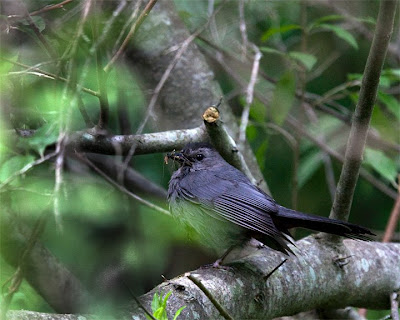Here's a youngster working on its new wings while mother looks on guardedly. The shot down below was from a few days ago while this catbird dodged in and out from the branches, but never leaving the scene. Simultaneously curious and cautious, it seemed.


From Florence Mirriam, an author who wrote for Audubon Magazine in 1886:
"High trees have an unsocial aspect, and so, as Lowell says, "The catbird croons in the lilac bush," in the alders, in a prickly ash copse, a barberry-bush, or by the side of the garden. In Northampton one of his favorite haunts is an old orchard that slopes down to the edge of Mill River. Here he is welcomed every year by his college girl friends; and in the open seclusion of an apple-tree proceeds to build his nest and raise his little family, singing through it all with keen enjoyment of the warm sunshine and his own company.
To the tyro the catbird is at once the most interesting and most exasperating of birds. Like some people, he seems to give up his time to the pleasure of hearing himself talk. A first cousin of the mocking-bird — whom he resembles in person much more than in voice — perhaps the relationship accounts for his overweening confidence in his vocal powers. As a matter of fact his jerky utterance is so harsh that it has been aptly termed asthmatic.
The catbird is unmistakably a Bohemian. He is exquisitely formed, and has a beautiful slate-gray coat, set off by his black head and tail. By nature he is peculiarly graceful, and when he chooses can pass for the most polished of the Philistine aristocracy. But he cares nothing for all this. With lazy self-indulgence he sits by the hour with relaxed muscles, and listlessly drooping wings and tail. If he were a man you feel confident that he would sit in shirt sleeves at home and go on the street without a collar.
And his occupation? His cousin is an artist, but he — is he a wag as well as a caricaturist, or is he in sober earnest when he tries to mimic the inimitable Wilson's thrush? If a wag he is a success, for he deceives the unguarded into believing him a robin, a cat, and — "a bird new to science! " How he must chuckle over the enthusiasm which hails his various notes and the bewilderment and chagrin that come to the diligent observer who finally catches a glimpse of the garrulous mimic!
The catbird builds his nest as he does everything else. The loose mass of coarse twigs patched up with pieces of newspaper or anything he happens to fancy, looks as if it would hardly bear his weight. He lines it, however, with fine bits of brown and black roots, and when the beautiful dark green eggs are laid in it, you feel sure that such an artistic looking bird must enjoy the contrasting colors."

Mirriam, Florence A. Birds Through an Opera Glass. Boston, 1986. 18-20. Google Book Search. Web. 24 Jun 2009.

No comments:
Post a Comment